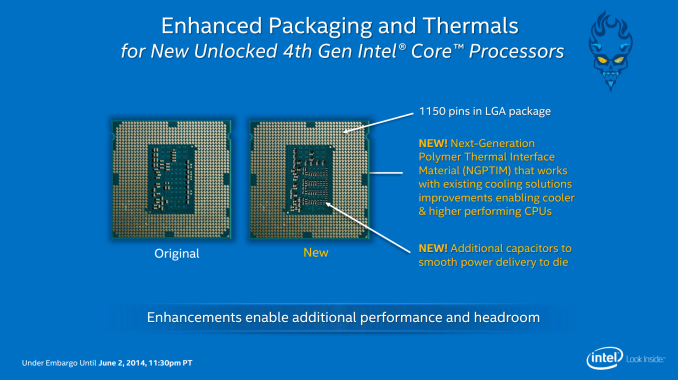Devil’s Canyon Review: Intel Core i7-4790K and i5-4690K
by Ian Cutress on July 11, 2014 10:00 AM EST- Posted in
- CPUs
- Intel
- Haswell
- i7
- Overclocking
- Devil's Canyon
- i5
- 4790K
- 4690K
Conclusions
End-users with CPU intensive workloads always feel justified in requesting for more performance. The only question is if that performance is required at the expense of power, and if the CPU company feel satisfied they can offer a higher performance component with absolute stability. Over the past three generations, Intel CPUs at equal frequency have offered a 5-10% performance boost over the previous generation, usually around the same power envelope. Because 2014 would seem to be a year where there is no major generation change for the mainstream market segment, in order to provide that 10% boost, they have had to go directly at clock speeds.
With the clock speed change, the package is also adjusted in two distinct ways. The first is to add extra decoupling capacitors on the PCB, allowing the voltage regulator on the die to deliver cleaner power to where it needs to go. The second addresses the issue of temperature, whereby the heat generated by the processor is removed. By adjusting the thermal interface material, Intel hopes to have a CPU that is ~10C cooler than the original Haswell CPUs at the same frequency and voltage. This latter part is directly observable, and even when overclocked, the ~10C temperature difference is very much visible.
This leads on to overclocking, the supposed reason for the release of Devil’s Canyon. Lisa Graff, VP and GM of Intel’s Desktop Client Platform Group, indicated in a press call before Computex that the lead design teams on Devil’s Canyon had six months to make the changes, and that the CPUs were aimed at addressing concerns levied at Intel from users who enjoy overclocking. The main concerns were the variability of the headroom of the Haswell CPU line, where some CPUs could only manage +5% whereas others gave +20% extra frequency, along with high temperatures at low clock speeds. By releasing the i7-4790K at 4.0 GHz/4.4 GHz Turbo, this ensures that the out-of-the-box i7-4790K has a better performance than the lowest performing overclocked i7-4770K CPUs. The adjustment in the thermal interface material (which we suspect is a change in the ceramic filler to an aluminum oxide or derivative therein) also gives more headroom for the i7-4790K CPUs that might have been temperature limited otherwise.
For our overclocking performance, both of our CPUs were hitting their voltage limitations as a result of the temperature adjustment. At the top end of our final overclocks, in order to adjust +100 MHz to be fully stable required a large jump of +0.100 volts, pushing the CPU voltage outside of the recommended window for a 24/7 stable Haswell-based processor. Both the i7-4790K and the i5-4690K in our testing gave 4.7 GHz benchmark stable, 100 MHz more than our first i7-4770K sample and 500 MHz more than our second i7-4770K sample.
This ends up being the main selling point for the overclocking end-user: if you own a relatively mediocre Sandy Bridge, Ivy Bridge or Haswell CPU, and have CPU limited throughput, there can be performance gains by investing into the Devil’s Canyon (CPU + Z97 motherboard or Z87 with BIOS updates) ecosystem. These are ‘enhancements’ that Intel should build on for the future, and never remove. I am sure that many enthusiasts would like to see a return to soldering the IHS on, or a single version with this feature.
For users relying on an Ivy Bridge stock system, the i7 Devil’s Canyon can offer a 17% increase over the i7-3770K for CPU benchmarks. For those that need the fastest single-thread VT-d enabled processor according to Intel's specification pages, the i7-4790K also affords that opportunity.
Users that are looking for the fastest GPU for gaming, at 1080p, might not be impressed by either the i5 or i7 Devil’s Canyon. At least in our testing, we saw no improvement from Ivy Bridge to Devil’s Canyon. One might argue that the story would be different for online gaming, or at larger resolutions, however for the latter there is more emphasis on upgrading the GPU over the CPU. While some hardware setups offer this mainstream CPU with three and four-way GPU gaming, typically we end up recommending the extreme platform due to fewer PCIe switches required.
The next question is oriented towards the future. Will the next generation of Intel CPUs perform better than Devil’s Canyon? The expected release date of Broadwell CPUs is still unknown, as is the extent of Intel's desktop offerings. Some media are expecting Broadwell to be more IGP focused as a platform, given the initial expectations of no desktop parts. To put this into perspective: if Broadwell offers a 5-10% IPC increase, Intel has to offer a 4.0 GHz / 4.4 GHz Turbo version in order to make their fastest mainstream processor even faster. However, given the history of Intel’s releases, if they release a top end i7, it will most likely be a 3.6 GHz / 4.0 GHz Turbo part, and offer the same performance as Devil’s Canyon. We cannot predict the overclocking potential, or if Intel is going to migrate the ‘enhanced overclocking features’ of Devil’s Canyon to the new parts. If this is the case, Intel will have to offer a new 'feature' to help sell the new high end parts.
The user has to hedge their bets – when is Broadwell coming to market, and is there going to be a large OC version of Broadwell, the equivalent of Devil’s Canyon is to Haswell? We are currently looking at 5 months away from Broadwell-Y (also known as Core-M) based on Intel announcements but no indication yet when Broadwell-DT is released, meaning an investment in Devil’s Canyon gives the top class mainstream processor based system until then.
The next piece of the puzzle is Haswell-E where many sources, such as CPU-World, are quoting that the low end SKU (an i7-5820K going by previous naming schemes) will be a six-core 3.3 GHz CPU with some amount of turbo. Historically Intel has charged roughly the same amount for the lowest Enthusiast CPU and the top Mainstream CPU, although this time the lowest Enthusiast CPU will have two more cores. So until Haswell-E is released, along with DDR4 and the X99 chipset, Devil’s Canyon might sit in the ‘should I wait’ category. But if we were looking at upgrading that main system today, based on CPU limited workloads, the i7-4790K is a well recommended choice.














117 Comments
View All Comments
Timur Born - Saturday, July 12, 2014 - link
My 4770K needs 1.25 volts just to hit stable 4.2 GHz on all cores. So a 4790K looks tempting. On the other hand I can get 4.4 GHz Turbo out of my 4770K at single/dual core operation, so in essence it is the same thing, just using higher voltages than a stock 4790K. Worth paying lots of money for that? Not so sure.doggghouse - Monday, July 14, 2014 - link
If you already have a 4770K, then buying a 4790K is basically just buying another ticket in the silicon lottery, unless you have a need for the extra enabled features (ex. VT-d). One good thing about 4790K is it's a higher binned chip, guaranteed to run at least 44-44-43-42 with default voltage (1.1v?). However, beyond that it may or may not have any overclocking headroom.Timur Born - Tuesday, July 15, 2014 - link
I agree. My 4770K needs 1.1v stock, hardly reaches those 44-44-43-42 at 1.3v (jury is still out on stability) and doesn't go to 43-43-43-43 at *any* voltage. So any lottery can only be better than what I already got. ;)I'm haggling with a friend who might want my CPU. Else I might just wait for Broadwell.
wrayj - Saturday, July 12, 2014 - link
I work in media production, and when dealing with 6k raw footage that must be decoded and debayered, our editing performance scales tremendously with more cores. The idea of an upcoming overclockable 8-core CPU with the fresh x99 platform is much more exciting to me than Devil's Canyon. Even at $1k, we're talking about a huge amount of value compared to xeon platforms.JanieEMontgomery - Saturday, July 12, 2014 - link
hyyymfenn - Saturday, July 12, 2014 - link
Ian, you can't have your cake and eat it to when it comes to proselytizing your overclocking viewpoints. For example, in the very same page of this review, you make the following statements:" A fair number of regular end-users ... can be concerned about overclocking..."
"To put the concept of 'overclocking death' into perspective: ... Out of the 250+ CPUs I own, I have only ever had one CPU fail."
"Personally, I shudder when a user suggests a system is not stable unless it passes ‘72hr Large FFT Prime95’, because I have seen users irreparably damage their CPUs with it. "
On the one hand you say that you've only broken one CPU by inputting wildly out of range values, the purpose of that statement is to tell people that they're probably not going to break their machine. On the other hand you're telling users that running a piece of application software could damage their (overclocked) CPUs.
So is overclocking a safe an fun hobby or isn't it? You need to make up your mind before trying to convince people of your position.
xeizo - Sunday, July 13, 2014 - link
Well he didn't, or did he? He just shared his reality which isn't black or white. It's grey, like the reality is. Of course there is danger for damaging the hardware when overclocking, what Ian means is that when sensibly doing so there is very little risk but he also warns about ridiculous stability testing(not "application software") which makes the chance of damaging the hardware much more likely. When in doubt, don't OC, and when doing it for fun the risk is part of the fun. Really.DeathMetroll - Sunday, July 13, 2014 - link
I'm currently using a I7 920@3.7Ghz, is it worth to go for a I5 4690K ? I'm just a gamer (BF4 and other 3D games)ZeDestructor - Monday, July 14, 2014 - link
Wait till Skylake would be my opinion. You'll get an even better boost, and move up to DDR4 and other good stuff.DeathMetroll - Monday, July 14, 2014 - link
Thanks for the answer, that's what I was thinkng about. But I don't know if I'm able to wait till then !!! ;)